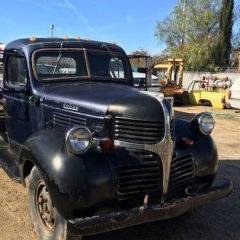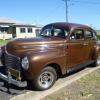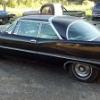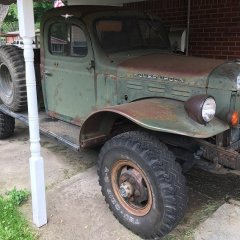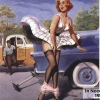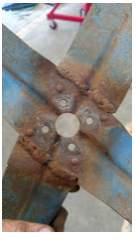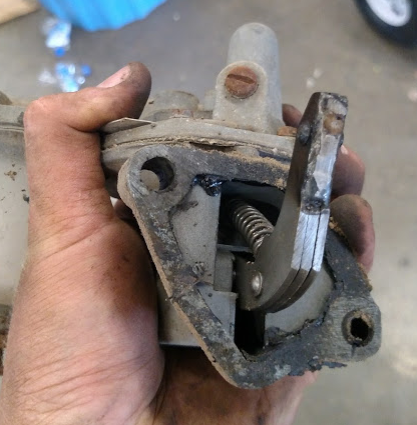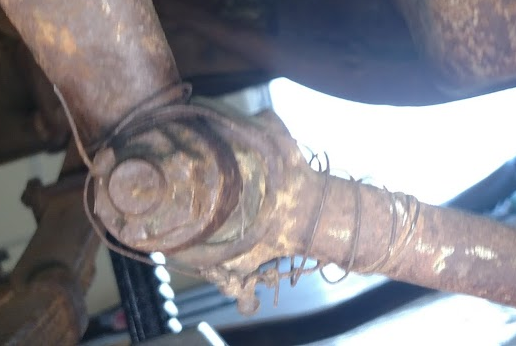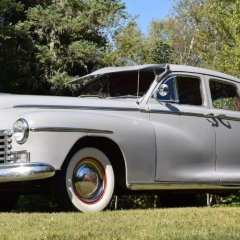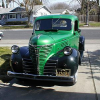Leaderboard
Popular Content
Showing content with the highest reputation on 02/05/2019 in all areas
-
2 points
-
The 5 on the dissy side of the block are 1 & 5/8th diameter, I always replace them with brass plugs, never steel and use a drift approximately 1/2" to 3/4" inch in diameter, even a large coach bolt with their large rounded head can work with the head against the plug tho hitting the opposite end of the bolt may buggar its threads...............plus some sort of non hardening gasket goo is useful so long as the hole edges in the block have been cleaned...........but as you don't want to do this again some sort of stop leak stuff should work, but isn't realy the best way but will work.............have you tried to give the plug another tap if its accessible?............regards, andyd.1 point
-
When you dimple your freeze plugs, it is really more of a flattening of its original dome shape, with maybe a slight dimpling or concavity, but not much. You want to use a flat drift that is almost as large as the plug itself. Hold the drift against the plug and give it a good whack with a meaty hammer. You don't want to end up with too deep of a dimple, especially one that is concentrated over too small an area of the plug. Creating a deep dimple is how many folks loosen up these plugs for removal, as it pulls the outside edges of the plug inward, away from the recess in the block. I have sometimes used a large ball peen hammer as the drift, using the large (almost flat) side as the drift, not the small (ball) side. The large side is close to being flat, while the ball side will create too much of a dimple. I hold that hammer firmly against the plug, then whack the back side (ball side) of it with another hammer. Use sealant. Some people use Indian Head gasket shellac, others use JB Weld, others use something else. I don't recall what I used. It should be non-hardening. Make sure the recess in the block is very clean and still has a good shoulder (not corroded away). Be aware that there is a plug on the front of the block, behind the timing chain cover, and if it starts to leak, it may contaminate your oil. So it's worth it to make sure it's ok.1 point
-
"What should I look for if I have someone turning steering wheel so I can watch under the hood? " You will need to get on the ground as someone works the steering wheel. There is a pitman arm attached to the steering box that translates the steering wheel input into left and right movement. That arm is short and exits from the steering box, and is fairly easy to identify. It should move with no slack in synch with the steering wheel. From the pitman arm, just follow the motion to the various linkages which finally attach to each front wheel. Do this inspection with the wheels on the ground. If it all looks ok from the pitman arm outwards, then you may indeed have something wrong in the box itself. Each movement of the steering wheel should transmit precisely to the pitman arm, with no slack if the box is ok. I'll bet it becomes pretty obvious what is out of whack. This sounds pretty serious. Don't drive it until you find the problem.1 point
-
It's a special fitting because of the needle seat required at one end. Both styles shown...1 point
-
I don't think it is possible to over filter fuel these days. Also if you have deleted the mechanical pump in favor of an electric then it is a good idea to have a real good filter ahead of your electric pump. I have been using large sealed canister filters on my truck and they get changed at 10k mile intervals. Seems to work very well. There is often a lot of crap suspended in under ground storage tanks. You definitely want to do what you can to keep it out of your carb and engine. Jeff1 point
-
Not sure if this has been posted before, but pretty fun read https://apple.news/AlNvm0UJKQmioODal0LMznA1 point
-
I go to bed at Midnight and usually wake up no more that 7 hours later. Trying too hard to sleep is sometimes self defeating.1 point
-
I think it's pointless and waste of money to purchase the platinum/iridium tipped spark plugs if you're still using breaker points and a distributor cap/rotor ignition system. You won't get to 100,000 miles on those plugs with that type of ignition system anyways. Once the breaker points become pitted and the cap/rotor wear and carbon up, the plugs really start to misfire anyways. It's really one nasty chain reaction once something starts to wear. With stock breaker point ignition, I would just use the regular copper core or standard plugs. If your engine is in good mechanical shape, with good compression/oil usage, carburetor and valve tappets adjusted correctly, then with the regular copper plugs, you should be able to make it to 10,000 to 15,000 miles before needing changing again. If you upgrade to electronic distributor-less ignition system, then get the platinum/iridium tip plugs for your 75,000 to 100,000 miles.1 point
-
If you're keeping the big wheels, IMO, keep the 4.78. Roughly the same RPM/MPH as the 4.1 and 6.70/15s.1 point
-
1 point
-
The rain came back so I spent the afternoon pulling the Dana 60 apart. As with everything that came off the old motor home, I was very happy to see the condition of the rear end. I will probably only replace seals and and wheel cylinders.1 point
-
LOL, I looked at that photo about 4 times before I finally saw it...... camouflaged very well glad it is received in the way it was intended, not slamming or knocking anyone's fixes.... they just make me laugh1 point
-
1 point
-
OK, here goes. For 10 -12 years I have silently read about everyone bashing Champion Spark Plugs on here. I have used them on my 1948 Chrysler Royals since 1974 without any starting or running issues. Never had one fail. Never had bad starts, slow starts, unless I neeeded to tweak my Points or Timing (which is probably the real culprit) or charge my battery if my Chrysler sat a month in the dead of Winter and I couldn't take it out every week because of snow or ice. So that being said Champions in my humble opinion are as good as any spark plug out there. I have had AC, Bosch, NGK in my Pontiacs, Chevy's, and Toyotas, and I really can't see any difference at all. As a matter of fact I found the Bosch Plugs ran too hot and didn't seem to do their job if any plug bashing must commence I personally would not buy a Bosch Plug again, however, Champions will always go in my Mopars RJ12C or 592 (Same Plug) at 35 Thousands of an Inch Gap. Running 6 Degrees Advanced on my Timing and always running Ethanol Free Gasoline - never the Cornalhol/Ethanol Gasoline.1 point
-
I like this thread. We chuckle today, but those fixes were of survival years. I've heard tell that coffee grounds would fix a leaking radiator.1 point
-
1 point
-
I had a hard time finding someone local who could/would fit the kingpin bushings. The first guy I tried ended up messing up the bushings - didn’t get the reamer properly aligned. I contacted Gary at Roberts Motor Parts and he hooked me up with a spare set of bushings without having to buy another kit. This time I decided to fit them myself. I turned an aluminum shaft down so that it easily slid through the bushings. I cut a groove the length of the shaft and slid a half sheet of 320 grit sand paper into the groove. Wrapping the paper around the shaft, I made a flap disk that slid through both bushings at the same time. I was able to slowly work the bushings to just over a .001” fit. Very happy with the fit and the way everything went together.1 point
-
It rained on and off all day so I spent the day assembling the front axel. Got the king pins fitted and installed, spring packs assembled with liners, and new tie rod ends. All new bushings and spring hardware - ready to hang back on the frame.1 point
-
Tying the gas pedal to the steering column was probably needed, if his pedal was like mine. The pedal is supported on two bolts on the floor, that have ball-shaped heads. The gas pedal is supposed to sort of snap onto the 2 balls, but as the pedal gets old, it does not stay. It tries to fall to the right side, making the rod that goes through the fire wall start binding. You can't fix this as you are driving along the road; trust me!1 point
-
1 point
-
Although the Drs. and their ilk recommend at least 8 hours, remember that is an average among millions of people. My Dad can't sleep more than 6 ours at night. He's tried to sleep more, but just can't, and doesn't feel any repercussions the next day. As Dodgeed noted, your body is best at determining what you need, absent any afflictions. And your body changes (duh). I only sleep a few hours at a time myself, it is indeed annoying, but only mildly so. I'd be worried about it depending on how I feel when I get up for the day. If you're worried about it, definitely ask your Dr. Sleep/rest is important, especially for a sunshiny and annoyingly cheerful disposition...1 point
-
You would think the amount of work it took to move that cab they could’ve just made the frame 6 feet longer.1 point
-
You could make one for almost nothing, and a gasket out of a hamburger helper box you've already got at the house anyway......finish up the job and go inside and have supper...mmmm, cheesy mac.1 point
-
Paul.....I have to say that you are doing a wonderful job and anyone would be proud to own it or be seen in it. Congratulations on a job well done.1 point
-
superbrightleds.com has the 6 volt LEDs If you want the dual element bulbs their part number is 1157-R19-6V . You need red LEDs for a red lens . They are VERY bright . If you are using LEDs on all four corners of your vehicle , you will need a special flasher that doesn't work on resistance . I found a LED correct flasher ( 6 volt ) on ebay from the UK from www.classiccarleds.co.uk ( the bulb part number might be only for negative ground 6 volt so check the information on their website ) .1 point
-
We grab 2 or 3 grand babies and keep them all day.....let them do whatever they want and sugar them up good before sending them home to our daughters...payback...lol...then you clean up what is left of the house, eat a light meal and hit the rack so exhausted you don't wake up until the rooster pecks on your window.1 point
-
I stillhave the original steel line running from the VA to the carb and I do not have any issues with adjusting the timing when rotating the dizzy. If replacing the line as suggested I would go with the Ni-cop line because it is easier to bend and then could use the rubber hose from the VA to the line if you need to make adjustments. Keep a metal line going over the top of the head. Rich Hartung1 point
-
I agree with desoto1939 as to the stock type. I did mine that way But it is hard to adjust timing with the normal steel line , I used even with a good sized loop. My thought if I needed to do it again would be to use the newer Ni-cop style of line which bends or add a section of vacuum hose with about 6-10 inches of rubber hose from the steel/Ni-cop line to the distributor. Your choice as to ease of service or stock type. DJ1 point
-
On my 1939 Desoto the entire line is a metal line from the Vacuum Advance over to the carb. They did put several loops in the line when coming out of the dizzy to help with the advance and retarding of the dizzy to prevent the breaking of the line. Rich Hartung desoto1939@aol.com1 point


